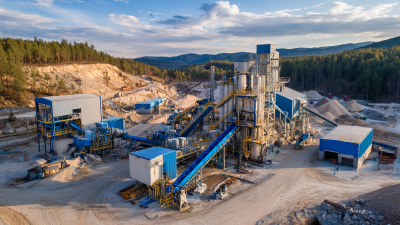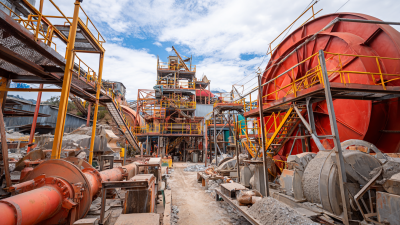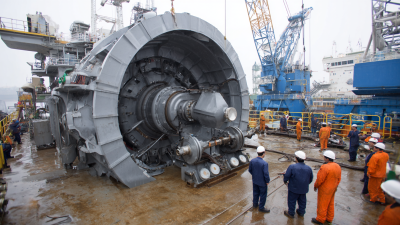

In the oil and gas world, making sure sand gets separated effectively is a big deal. It really helps keep the equipment in good shape and ensures that production runs smoothly. I recently came across a market report that says the global sand control systems market might hit around USD 4.2 billion by 2026. That’s mainly because there's a rising demand for better, more efficient ways to manage sand. One of the standout technologies right now is the Cone Desander — it’s become pretty much essential for getting sand out effectively. A company that's been leading the charge here is Shanghai Shangjiang Petroleum Engineering Equipment Co., Ltd. They’ve been pushing the envelope with new cyclone separation products and tech that are designed specifically to meet the industry’s needs. Thanks to their innovative designs and better materials, Cone Desanders aren’t just good at removing sand—they also help make operations more sustainable overall. This makes them a really important part of the drive towards more cost-effective and efficient oil and gas extraction processes.

When you're choosing cone desanders for sand separation, there are a few key features you really wanna keep in mind to make sure they work well. One of the most important things is the cone angle — it seriously affects how well the device can separate materials. Recent research shows that even small tweaks to the cone angle in hydrocyclones can make a big difference, especially when the density difference between materials isn't huge. That’s pretty crucial in applications like recycling waste plastics, where getting the most recovery out of materials matters a lot, and optimizing the cone angle can really boost those results.
Of course, efficiency is a big deal too. Mini-hydrocyclones, for example, have shown they can hit separation efficiencies of up to 80%, especially when dealing with microspheres and sand in non-Newtonian fluids. That level of performance is pretty much a must-have in operations that need solid materials removed effectively — like drilling, where getting rid of drill cuttings is super important. And on top of that, using advanced pump sand protection tech is becoming more common. It helps shield pumps from those abrasive particles, which not only extends how long the equipment lasts but also makes the whole sand separation process smoother. All in all, these improvements can cut down on maintenance costs and reduce downtime, which is always a win.
 Cone desanders might not be something you hear about every day, but trust me, they’re pretty important when it comes to managing sand in various industries—especially in oil and gas, mining, and water treatment. Basically, these handy devices are built to snatch out sand and other solids from liquids, so your production line keeps running smoothly without hiccups or risking damage to your equipment from those pesky abrasive particles. Keeping things running at peak performance not only boosts productivity but also helps your machinery last longer, which makes investing in cone desanders a smart move if you're dealing with sand-heavy fluids.
Cone desanders might not be something you hear about every day, but trust me, they’re pretty important when it comes to managing sand in various industries—especially in oil and gas, mining, and water treatment. Basically, these handy devices are built to snatch out sand and other solids from liquids, so your production line keeps running smoothly without hiccups or risking damage to your equipment from those pesky abrasive particles. Keeping things running at peak performance not only boosts productivity but also helps your machinery last longer, which makes investing in cone desanders a smart move if you're dealing with sand-heavy fluids.
When you're picking out a cone desander, it’s a good idea to think about the specific needs of your application and what flow rates you’re dealing with. Getting the right size and type makes a big difference in how well they separate out the sand. Oh, and don’t forget—regular maintenance is key. Make sure you clean and check on your equipment often, so buildup doesn’t slow things down or cause issues.
If you want to get the most out of your sand separation, go for high-quality desander units built from tough materials that resist wear and tear. Keeping a close eye on how much sand is accumulating can also help; automating some of that monitoring can save you time and help you catch problems early. And finally, training your team on how to properly operate and maintain these units not only keeps things running smoothly but also makes the workplace safer and more efficient.
If you're looking to boost how well you separate sand in your operations, picking the right cone desander is pretty much a big deal. I mean, according to a 2023 market analysis from the Global Filtration Insights report, the demand for better sand separation solutions in the oil and gas world has jumped by around 15% over the last year. That’s mainly because more fluids carrying sand are being produced, and companies really need advanced tech that can help cut down on downtime and keep production running smoothly.
Nowadays, the top cone desanders out there in 2023 come with some pretty innovative designs, each one built to tackle specific challenges. For example, the newest models are equipped with some pretty advanced vortex capabilities, which means they can separate over 95% of the sand out. There was this study by the Separation Technology Forum that pointed out: when these desanders use high-performance materials, they last way longer — some models reportedly last about 30% longer than the older versions. These upgrades aren’t just about getting more done — they also help save on maintenance costs, making them a smart investment for anyone serious about efficiency out in the field.
When you're setting up cone desanders, paying attention to the little details can really make a big difference in how well they perform. One thing that’s super important is keeping on top of maintenance and knowing when to swap out parts like cone liners. Changing these at the right time can actually boost crushing efficiency and help them run longer—crucial for getting the best sand separation possible. It’s a good idea to keep an eye on how quickly wear occurs and notice any patterns, since that can change depending on what kind of materials you're working with.
If you’re looking to squeeze even more efficiency out of your cone desanders, it doesn’t hurt to check out the design stuff, like vortex generators. Recent research suggests that the way these are designed can really affect how well everything works. Trying out different designs—like twisted baffles or changing the pitch of cyclone setups—could lead to better gas-solid separation. So, by paying attention to these tips during installation and staying proactive with maintenance, you can keep your cone desanders running at their best, hassle-free.
Basically, good maintenance is key if you want your cone desanders to last longer, especially when they’re protecting really important gear like electric submersible pumps (ESPs). Just recently, some field tests in Canada showed that using downhole desanders can really cut down on failures caused by sand messing things up. It just goes to show that sticking to a regular maintenance routine is super important if you want your equipment to perform at its best. Industry reports even say that taking proper care can boost the lifespan of your equipment by up to 30%. That’s a big deal because it helps you avoid those costly downtimes and makes managing sand much easier overall.
On top of that, more and more folks are turning to advanced options like subsea bypass systems—they’re a clever way to keep sand away from the most sensitive parts of the setup. This usually means upgrading the existing cyclonic wellhead desanders to make them more effective in subsea conditions. Simple things like regular inspections, cleaning, and swapping out worn parts can make a big difference—reliability improves, and your equipment stays in shape longer. Putting these good practices into action not only protects your cone desander but also keeps everything running smoothly without interruption. All in all, these steps really push sand separation to new levels of efficiency.
| Model | Separation Efficiency (%) | Inlet Size (inches) | Outlet Size (inches) | Maintenance Frequency (Months) | Expected Lifespan (Years) |
|---|---|---|---|---|---|
| Model A | 95 | 6 | 4 | 12 | 10 |
| Model B | 93 | 8 | 5 | 10 | 8 |
| Model C | 90 | 7 | 4 | 8 | 7 |
| Model D | 97 | 5 | 3 | 15 | 9 |
| Model E | 92 | 6 | 4 | 11 | 8 |
In the oil and gas world, making sure sand gets separated effectively is a big deal. It really matters because it helps keep the equipment in good shape and makes sure production runs smoothly. I’ve come across a few recent projects that really show how useful cone desanders are in real-life situations. For example, the International Energy Agency did a survey and found that adding cone desanders can cut down sand erosion by up to 75%. That’s a huge deal because it means downstream equipment lasts longer — which is especially important when you're dealing with offshore rigs, where sand in the system can mean costly downtime and repairs.
Take the North Sea offshore drilling project, for instance. They installed cone desanders there and saw their costs drop by about half when it came to handling sand and maintaining their gear. The system they put in was pretty impressive — over 90% separation efficiency, which basically means much cleaner returns to the processing units. All of this just shows that using advanced sand management tools isn’t just some fancy tech — it really helps improve overall production, making things safer and more reliable, even in rough environments.

: The cone angle is crucial because it significantly impacts separation efficiency, especially in applications where density differences are minimal, such as recycling waste plastics.
Mini-hydrocyclones can achieve separation efficiencies of up to 80% when used for microspheres and sand in non-Newtonian fluids.
This technology protects pumps from abrasive materials, extending their operational lifespan and enhancing overall sand separation processes while reducing maintenance and downtime costs.
Properly timed replacement of cone liners can enhance crushing efficiency and extend performance, which is vital for optimizing sand separation processes.
It is essential to closely monitor wear rates and patterns of the cone liners, as they may vary based on the specific application and materials processed.
The design of vortex generators can significantly influence overall performance, and experimenting with different designs may lead to improvements in sand separation effectiveness.
Twisted baffles are design features within the cyclone that have shown potential for improving gas-solid separation, enhancing the efficiency of the separation process.
The removal of drill cuttings is critical, making it essential to employ cone desanders with high efficiency for effective solids management.
Proactive maintenance, including timely changeouts of liners and monitoring of component wear, is vital for ensuring cone desanders operate at peak performance levels.
Implementing advanced sand protection technologies can enhance sand separation processes, ultimately reducing maintenance and downtime costs in these environments.
When it comes to improving sand separation in the oil and gas world, picking the right Cone Desander really makes all the difference. Our blog dives into what you should look for in a good Cone Desander—because let's face it, it’s a crucial part of managing sand effectively. We'll also compare some of the top models out there in 2023, so you have all the info you need to make a smart choice without the headaches.
Plus, we throw in some handy tips on installing and maintaining your equipment to help it run smoothly and last longer. We even share real-life stories of how these devices have made a big difference in actual field operations—kind of eye-opening, right? As Shanghai Shangjiang Petroleum Engineering Equipment Co., Ltd. keeps pushing forward with new tech in cyclone separation, our goal is to give you insights that help you step up your sand separation game.
Basically, we want to make sure you’re well-equipped with the info you need, without all the confusing jargon. Let’s make your sand management easier and more efficient!






